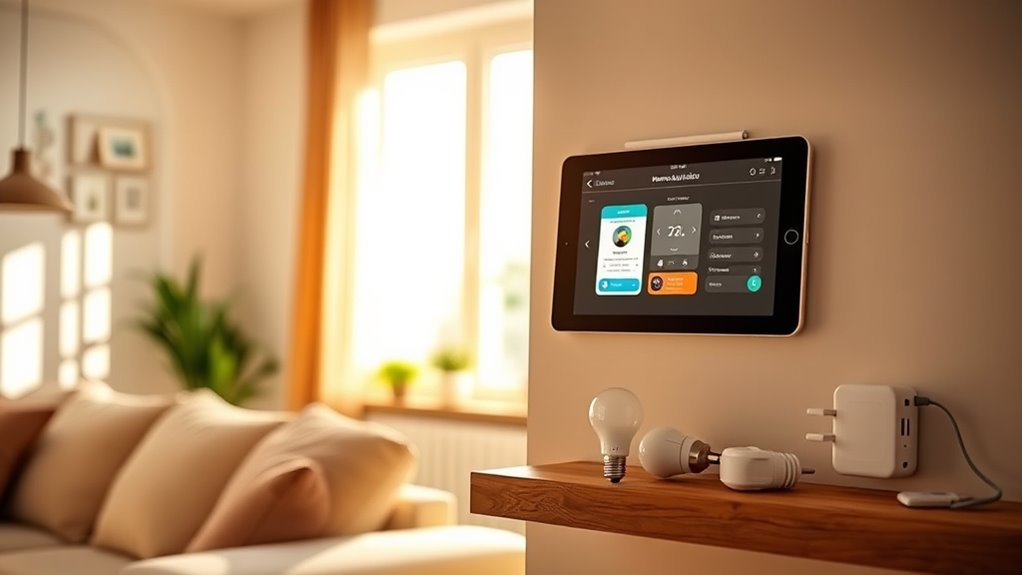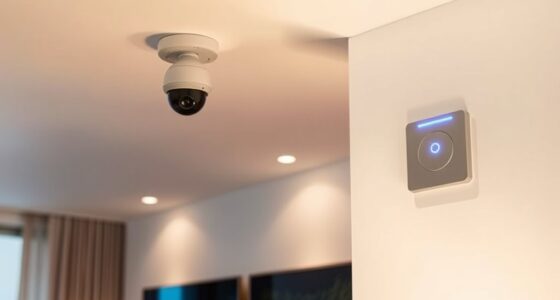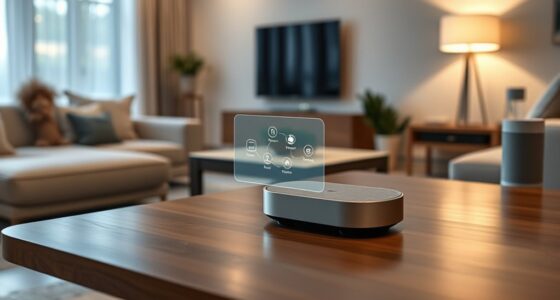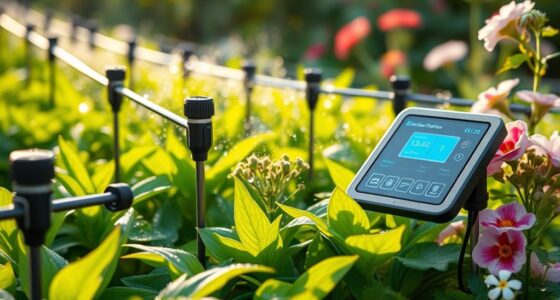To build a smart home on a budget, start by setting clear priorities and a realistic budget. Choose a central hub for easy device connection and pick compatible, affordable devices that suit your needs. Opt for DIY installation and use free or low-cost automation apps to streamline control. Expand gradually, taking advantage of sales and discounts as you go. Keep your system updated and secure to save money long-term. Explore more tips for cost-effective smart home setup ahead.
Key Takeaways
- Set a clear budget and prioritize essential features like security and energy efficiency to avoid overspending.
- Choose compatible, easy-to-install wireless devices from reputable brands to reduce setup costs.
- Build your system gradually, focusing on core devices first, and expand over time with sales and bundled deals.
- Use free or low-cost automation apps to streamline control, routines, and remote access for cost-effective management.
- Regularly update firmware, replace outdated hardware, and implement security best practices to protect and maintain your system.
Assess Your Smart Home Priorities and Budget
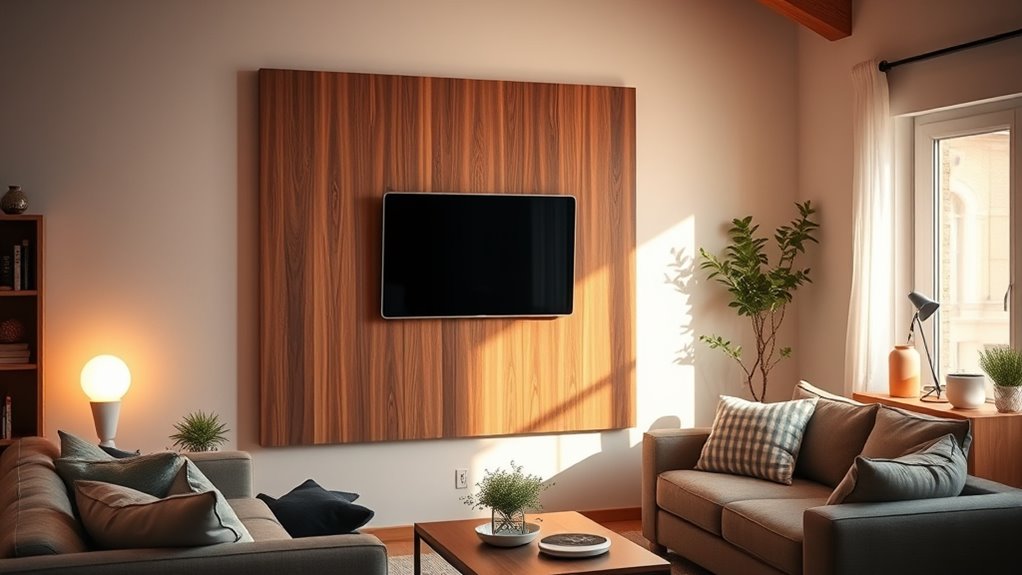
Before diving into smart home devices, understanding what matters most to you and how much you’re willing to spend is vital. Start with budget planning to determine your overall spending limit. This helps you avoid overspending and guarantees you’re making thoughtful choices. Next, priority setting guides your decisions—decide which features are essential and which can wait. Do you want security, energy efficiency, or convenience? Focusing on your top priorities allows you to allocate funds wisely. Remember, a smart home doesn’t have to be expensive; it’s about smartly choosing devices that fit your needs and budget. Being aware of smart home device features can help you select options that align with your goals. Additionally, understanding privacy policies related to smart devices ensures your data remains protected as you build your setup. Considering compatibility between devices can streamline your system integration and improve user experience. Implementing quality assurance practices in your device selection process can help ensure reliability and performance. Staying informed about security vulnerabilities related to smart devices can further protect your home network. By clearly defining your goals and financial boundaries upfront, you’ll create a realistic plan that maximizes value without breaking the bank.
Start With a Central Hub for Connectivity
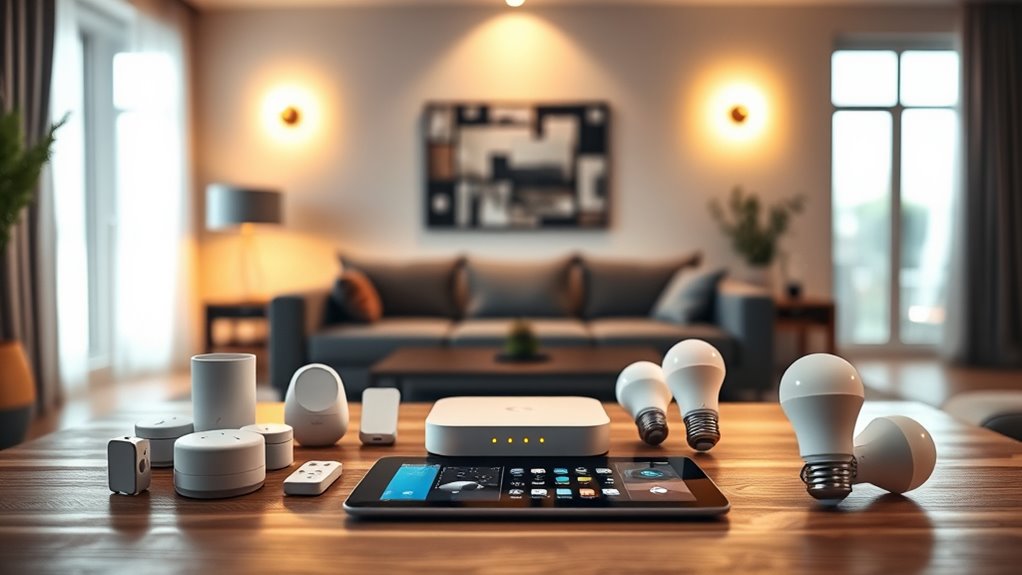
Starting with a central hub helps you connect all your smart devices smoothly. Make sure the devices you choose are compatible and use wireless connectivity to save costs. A user-friendly app will keep things simple when managing your smart home setup. Implementing automotive tuning techniques can optimize device performance and responsiveness for a more seamless experience.
Choose Compatible Devices
Choosing compatible devices is essential for building a seamless smart home system, and beginning with a central hub simplifies connectivity. When selecting devices, focus on device compatibility to ensure they work smoothly together. An ecosystem that integrates well helps avoid frustration and additional costs from incompatible gadgets. Look for products labeled as compatible with your chosen hub or platform, such as Zigbee or Z-Wave. This guarantees easier setup and reliable operation across your devices. Staying within an ecosystem minimizes technical issues and helps you expand your smart home over time. Remember, a cohesive system saves money and effort, so prioritize compatibility and ecosystem integration when choosing your devices. This approach creates a more reliable, user-friendly smart home experience on a budget. Maximize compatibility by considering how devices communicate and connect within your chosen ecosystem.
Opt for Wireless Connectivity
Opting for wireless connectivity simplifies building a smart home by reducing the need for extensive wiring and making device placement more flexible. A central hub acts as the core, connecting your devices via Wi-Fi or Zigbee, enhancing overall convenience. Wireless security is vital; choose hubs with strong encryption to protect your data from breaches. Many devices support Bluetooth pairing, allowing quick and easy setup without complicated wiring. This approach also supports secure data transmission, which is essential for protecting sensitive information within your smart home. Wireless connections also enable remote access, so you can control your smart home from anywhere. Additionally, understanding home furnishings safety features can help you select compatible devices that prioritize user safety. By prioritizing wireless connectivity, you create a flexible, scalable system that’s easy to expand as your needs grow—all while staying budget-friendly.
Use a User-Friendly App
A user-friendly app is essential for managing your smart home effortlessly, especially when paired with a central hub that connects all your devices. Look for an app that supports voice control and remote access, making it easy to operate your system from anywhere. A simple interface reduces frustration and saves time, allowing you to control lights, thermostats, and security with minimal effort. When choosing an app, consider compatibility with your devices and future scalability. Incorporating ease of use into your selection process ensures a more enjoyable and efficient smart home experience. Additionally, selecting an app with water resistance features can prevent issues caused by accidental spills or exposure to moisture, further simplifying your home management. Ensuring your app is compatible with smart device ecosystems can also streamline setup and future expansion. Choosing an app that emphasizes user-friendly design can significantly enhance your overall experience and reduce the learning curve.
Choose Compatible and Affordable Devices

Since budget constraints are a common concern, selecting compatible and affordable devices is essential for building a smart home that doesn’t break the bank. Focus on device compatibility to guarantee everything works seamlessly together, reducing frustration and extra costs. Look for budget-friendly options from reputable brands that offer solid features at lower prices. Prioritize devices that connect easily with your existing system or hub, avoiding the need for costly adapters or upgrades. Check reviews and specifications to verify compatibility and reliability. By choosing devices designed to work with common platforms like Alexa, Google Assistant, or Zigbee, you’ll create a cohesive smart home without overspending. Understanding the importance of standards and interoperability can help you make smarter choices and ensure your devices work well together. Additionally, selecting devices with affordable price points can further enhance your budget-friendly setup. Incorporating energy-efficient devices can also help reduce long-term costs and improve overall home sustainability. When planning your setup, consider expandability options to ensure your system can grow with your needs without requiring a complete overhaul. Remember, smart doesn’t have to mean expensive—smart choices lead to a more efficient, budget-friendly setup.
Opt for DIY Installation to Save Costs
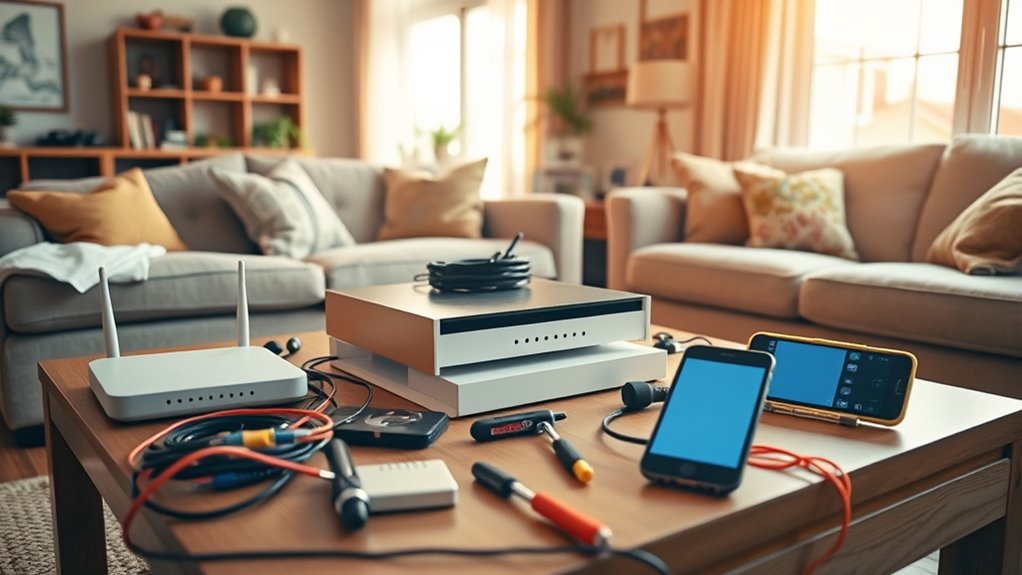
Choosing devices that are easy to install can greatly cut your costs and time. Follow detailed setup guides to guarantee a smooth process without professional help. With the right tools and clear instructions, you can handle the installation yourself and save money. Additionally, selecting products with clear hours or online resources can help you plan your installation during convenient times. Understanding pairing options can also simplify connecting your devices, saving you both time and frustration. Being aware of installation requirements ensures compatibility and reduces potential troubleshooting issues. Considering product documentation can further streamline the setup process and avoid common pitfalls. Embracing a mindset that views failure as a learning opportunity can also help you troubleshoot unexpected issues during installation and improve your future DIY projects.
Choose Easy-to-Install Devices
Opting for easy-to-install devices can substantially cut your smart home setup costs, especially when you handle the installation yourself. Devices like wireless security cameras and smart lighting often feature simple setups that don’t require professional help. Look for products that offer plug-and-play functionality, minimal wiring, and clear instructions. These devices not only save money but also save time and frustration. Consider:
- Wireless security cameras with quick setup
- Smart bulbs that just screw in
- Wi-Fi-enabled door locks
- Plug-in smart outlets
- Battery-powered sensors
Choosing devices designed for DIY installation ensures you stay within budget and avoid costly professional fees. Plus, easy-to-install options make expanding your smart home simple, allowing you to add new features over time without hassle.
Follow Detailed Setup Guides
Following detailed setup guides can greatly reduce your smart home installation costs by empowering you to handle the process yourself. Whether you’re setting up smart home security cameras or smart lighting control, these guides provide step-by-step instructions, making DIY installation manageable. You’ll save money on professional fees and gain a better understanding of your devices. Clear instructions help you troubleshoot potential issues, ensuring your system works smoothly. Focus on guides tailored to your specific devices, and don’t rush—precision matters. With patience, you can confidently install and configure your smart home security system or lighting controls, creating a safer, more efficient space. Following these guides turns a costly project into an achievable DIY task, maximizing your budget investment.
Utilize Free and Low-Cost Automation Apps
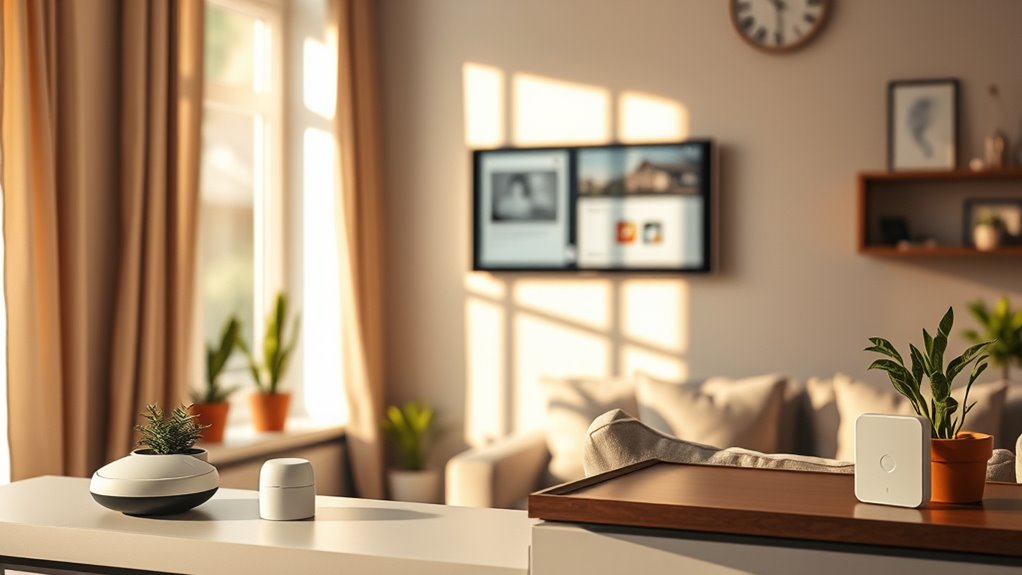
Many free and low-cost automation apps can help you turn your house into a smart home without breaking the bank. These apps often support a wide range of devices, improving device compatibility and making integration easier. By exploring popular options, you can customize your setup without overspending.
Consider these benefits:
- Compatibility with multiple smart devices
- User-friendly interfaces for easy setup
- Automation routines to save time
- Remote control via smartphones
- Regular updates and community support
Using these apps, you can create complex automation routines or simple triggers to enhance convenience. Many free options are versatile enough to grow with your smart home, ensuring you get the most out of your budget while maintaining seamless device compatibility.
Focus on Energy Efficiency to Save Money Long-Term
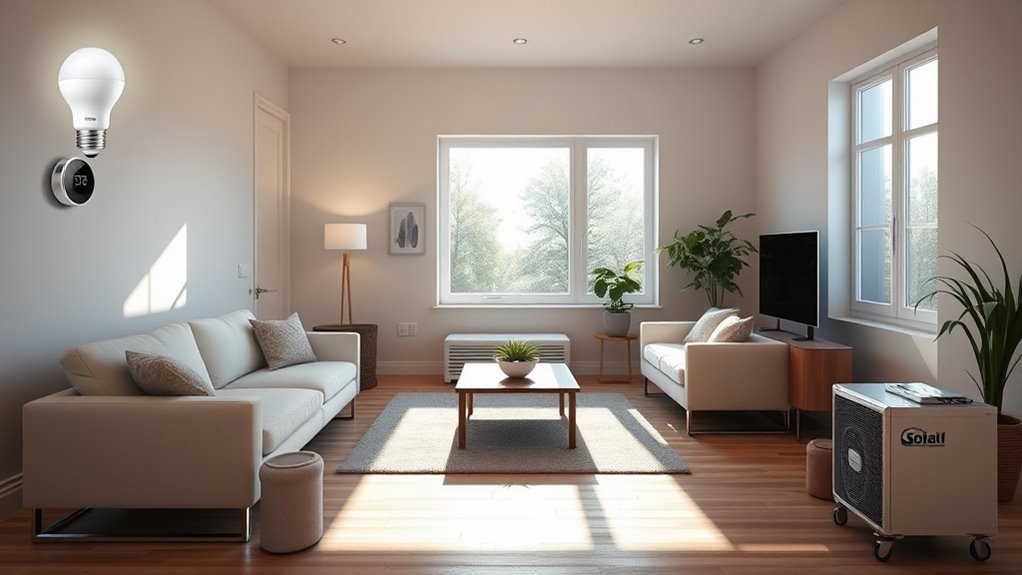
Focusing on energy efficiency can profoundly cut your long-term costs. By choosing energy-efficient appliances, installing smart thermostats, and switching to LED lighting, you optimize your home’s energy use. These small upgrades make a big difference over time.
Choose Energy-Efficient Appliances
Choosing energy-efficient appliances is one of the smartest ways to lower your long-term home costs. These appliances use less energy, saving you money on utility bills over time. When making your selection, perform an appliance comparison to find models that offer the best energy saving tips. Look for ENERGY STAR ratings, which indicate high efficiency. Consider these factors:
- Check for smart features that optimize energy use
- Prioritize appliances with lower wattage
- Compare annual energy consumption labels
- Read reviews focused on durability and efficiency
- Select appliances suited to your household size
Install Smart Thermostats
Installing a smart thermostat is a highly effective way to boost your home’s energy efficiency and save money over time. These devices use advanced temperature sensors to accurately monitor your home’s climate, adjusting heating and cooling automatically for ideal comfort. By learning your schedule and preferences, a smart thermostat prevents unnecessary energy use when you’re away or asleep. Pairing it with smart vents allows for even better zone control, directing airflow to rooms that need it most and reducing waste. This targeted approach minimizes energy consumption and lowers utility bills. Over time, the combined use of temperature sensors and smart vents maximizes efficiency, helping you save money while maintaining a comfortable home environment.
Use LED Lighting
Switching to LED lighting is one of the most cost-effective ways to reduce your home’s energy consumption. LEDs use considerably less power and have a longer lifespan, saving you money over time. Plus, with a variety of LED color options, you can create the perfect ambiance for any room. When choosing LEDs, take into account their LED lifespan to ensure durability and long-term savings. Here are some benefits to consider:
- Save on energy bills with lower power usage
- Enjoy customizable LED color options for mood lighting
- Reduce replacement frequency due to longer LED lifespan
- Enhance your home’s smart lighting capabilities
- Make eco-friendly choices that benefit the environment
Switching to LEDs is a smart move for a budget-friendly, energy-efficient home.
Incorporate Voice Assistants for Convenience
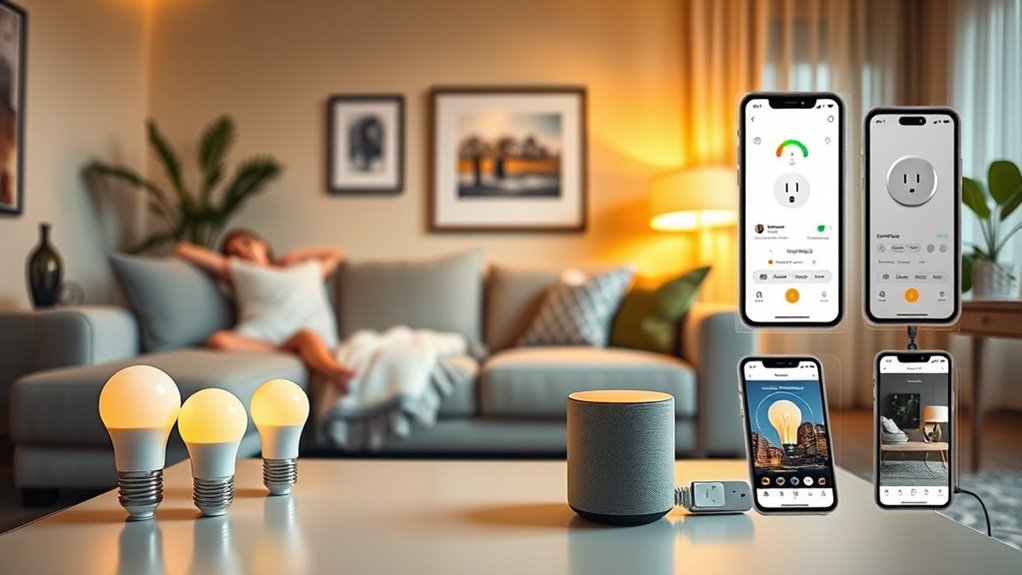
Integrating voice assistants into your smart home can substantially boost convenience without breaking the bank. With simple voice assistant integration, you can control lights, thermostats, and devices using natural language commands. This hands-free control makes daily routines easier, saving you time and effort. To get started, choose a popular voice assistant like Amazon Alexa or Google Assistant, which are often affordable and compatible with many smart devices. Once set up, you can ask your voice assistant to turn on the lights, adjust the temperature, or play music, all with just your voice. This seamless interaction enhances your smart home experience while keeping costs low. Plus, as you expand your system, voice commands remain a straightforward way to manage your devices effortlessly.
Expand Gradually to Avoid Overspending
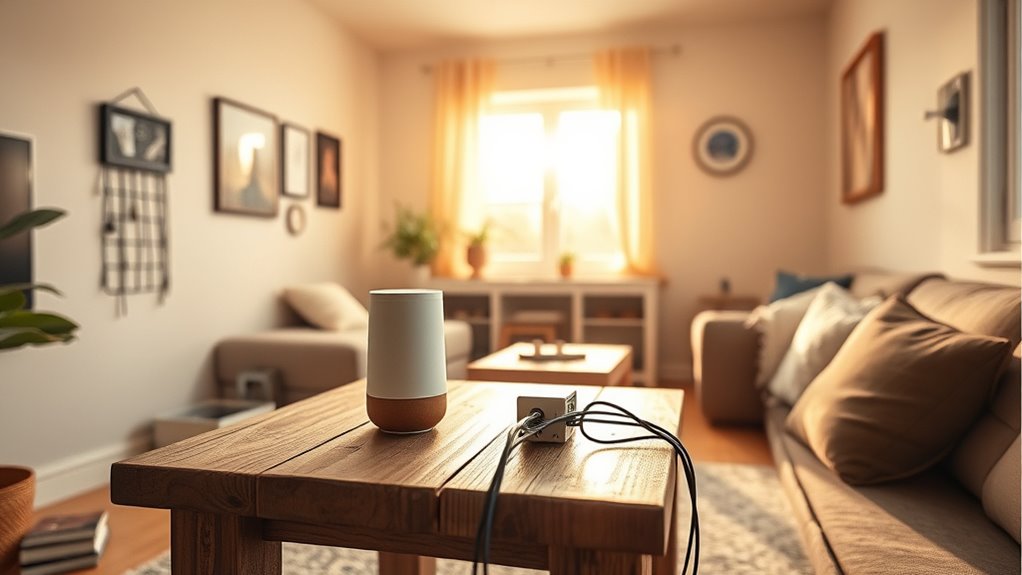
To make the most of your smart home without overspending, it’s important to expand your system gradually. Start with a clear budget plan, setting limits for each upgrade. Focus on feature prioritization by identifying what matters most—security, energy savings, or convenience. This helps you avoid impulse buys and unnecessary expenses.
To keep your expansion on track, consider these tips:
- Add devices one at a time to monitor spending.
- Research compatibility before purchasing new gear.
- Prioritize essential features over luxury options.
- Set a timeline for upgrades to stay organized.
- Reassess your budget regularly to stay aligned with your goals.
Take Advantage of Sales and Discount Events
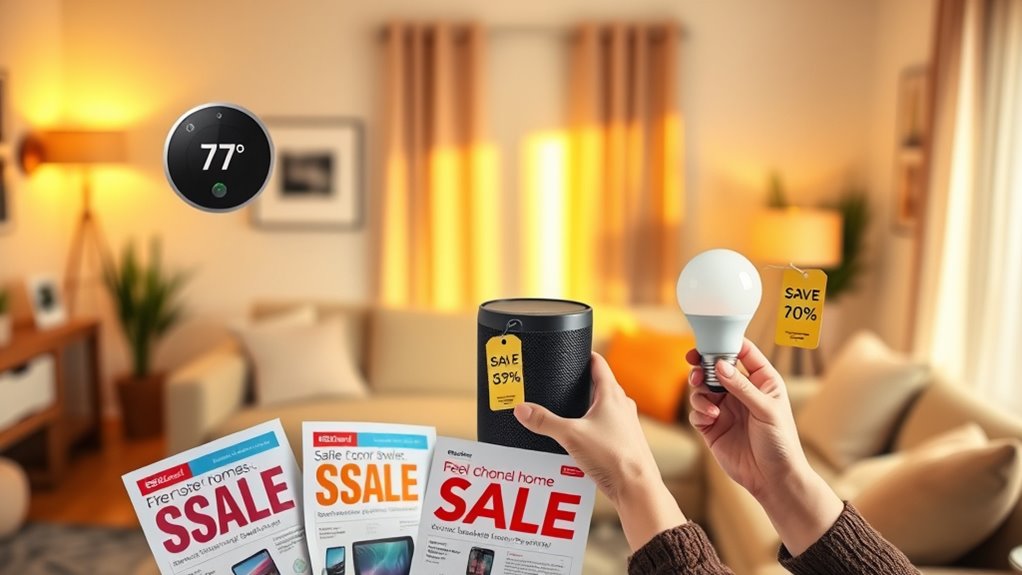
Taking advantage of sales and discount events can markedly reduce the cost of building your smart home. Look out for deals on smart home security systems, which often go on sale during holiday promotions or seasonal events. These discounts make it affordable to install cameras, alarms, and other security features to protect your home. Additionally, sales on voice control integration devices, like smart speakers and hubs, can help you upgrade your system without overspending. Keep an eye on online retailers, local stores, and manufacturer promotions to snag the best deals. Timing your purchases around major sales events allows you to maximize savings and access quality products that might otherwise be out of reach. Being strategic with your shopping can help you create a smarter, safer home on a budget.
Maintain and Upgrade Your System Smartly
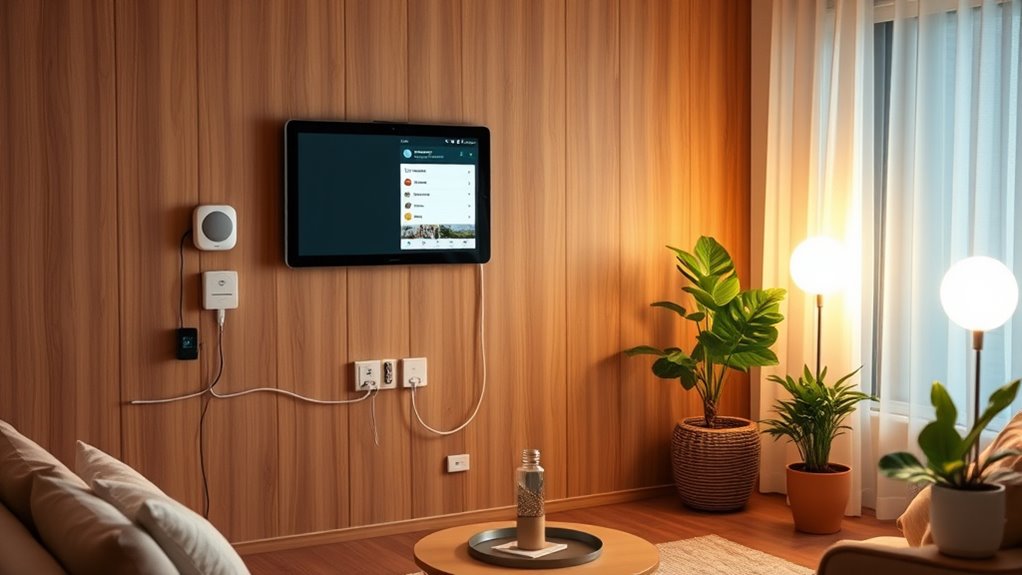
Maintaining and upgrading your smart home system efficiently guarantees it remains secure, functional, and cost-effective over time. Regular updates help prevent security breaches, while thoughtful improvements enhance aesthetics and usability. To stay ahead, consider these tips:
- Schedule firmware updates for security upgrades.
- Replace outdated devices with newer, more efficient models.
- Integrate aesthetic enhancements like stylish covers or lighting.
- Monitor system performance to identify needed upgrades.
- Prioritize security features during upgrades to protect your home.
Frequently Asked Questions
How Can I Ensure My Smart Devices Protect My Privacy?
To protect your privacy with smart devices, you should regularly review and update privacy settings, ensuring only necessary data is shared. Enable data encryption on your devices and networks to secure your information from unauthorized access. Use strong, unique passwords and two-factor authentication whenever possible. Also, disable features or permissions you don’t need, and stay informed about any privacy updates from device manufacturers to keep your data safe.
What Are the Most Cost-Effective Smart Home Security Options?
When choosing smart home security, look for affordable security options that fit your budget. You can find budget-friendly options like Wi-Fi cameras, door/window sensors, and smart locks that don’t compromise on quality. These devices are easy to install and often come with free or low-cost apps. By prioritizing these affordable security solutions, you can protect your home effectively without overspending, ensuring safety and peace of mind.
Can I Integrate Legacy Devices Into a New Smart Home System?
You can definitely integrate legacy devices into your new smart home system. Focus on compatibility and look for legacy integration options, like hubs or bridges, that connect older devices to modern platforms. Many smart home systems support device compatibility through third-party apps or firmware updates. By ensuring your legacy devices are compatible, you’ll extend their usefulness and seamlessly control everything from one central app, making your smart home more efficient and user-friendly.
How Do I Troubleshoot Connectivity Issues Between Devices?
When troubleshooting connectivity issues between your smart devices, start by checking for firmware updates, as outdated software can cause problems. Make certain your network is optimized by implementing network segmentation to reduce congestion and improve stability. Restart your devices and router, and verify they’re connected to the correct network. If issues persist, reset devices or reconfigure your network settings. These steps help establish a reliable connection across your smart home system.
What Are the Best Practices for Maintaining Data Security in My Smart Home?
To keep your smart home data secure, you should implement strong encryption protocols for all devices and communications. Regularly update your firmware and software to patch vulnerabilities. Control user access carefully by setting unique passwords and enabling multi-factor authentication where possible. Keep your Wi-Fi network secure with a strong password and disable remote access if you don’t need it. These steps help protect your data and ensure your smart home remains safe.
Conclusion
Building a smart home on a budget is totally doable—you just need to plan wisely. Did you know that 65% of smart home owners save money in the long run by choosing affordable devices and gradual upgrades? By prioritizing your needs, starting small, and taking advantage of sales, you can create a convenient, connected space without breaking the bank. Stay patient and strategic, and your smart home dreams will become reality without overspending.

